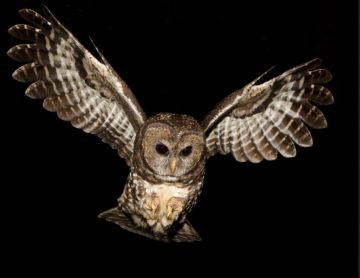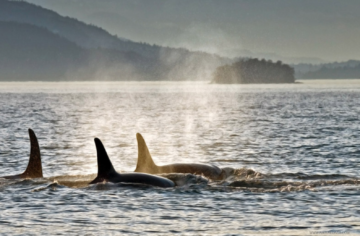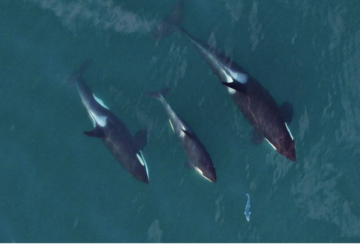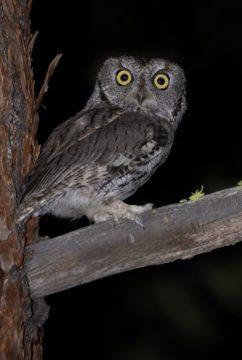by David Greer

The northern spotted owl (Strix occidentalis caurina) and the southern resident orca (Orcinus orca) are dramatically different animals that employ curiously similar predation techniques, and both face extinction thanks in large part to their choice of prey.
The northern spotted owl, one of three subspecies of spotted owls, is slightly smaller than a raven and inhabits mature forests along the Pacific coast of North America from southwestern British Columbia to northern California. The southern resident orca, sometimes called the killer whale, occupies the same part of the world and is found primarily in the coastal waters of British Columbia, Washington and Oregon, and most especially throughout the Salish Sea.
Though the extinction threats they face are different in nature, there is one very similar root cause—the fact that they are both fussy eaters.
The diet of the spotted owl consists primarily of two small rodents: bushy-tailed wood rats (otherwise known as pack rats) and flying squirrels. Like most other owls, the spotted owl hunts primarily in the dark. To catch its prey efficiently with minimal expenditure of energy, it has evolved two remarkable and complementary aptitudes: exquisite hearing and silent flight. Unlike some owl species that prowl at night in search of prey, the spotted owl simply perches in a tree, waits motionless, and intently listens. If it hears the scratching of pack rat toenails on a log or the soft impact of a flying squirrel landing on a tree trunk, it unfolds its wings and launches towards the sound. Like other owls, the spotted owl has evolved a structure and texture of feathers that ensures an almost soundless flight.

Silent flight not only deters prey from detecting the approaching predator, it may also enable the owl to continue to hear its prey while it nears its target without being distracted by the sound of its own flapping wings. The comparative silence of owl flight is dramatically illustrated in a video of a BBC Earth experiment comparing the flight noise of a pigeon, a peregrine falcon, and a barn owl.
Ancient forests are ideal for spotted owl habitat because the open character of their understory makes it easier for the bird to swoop soundlessly towards prey between widely spaced trees. Perhaps more importantly, such forests contain an abundance of nest sites. Owls do not build their own nests; instead, they occupy cavities in dead or dying trees or take over stick platform nests bult by hawks. The northern spotted owl not only prefers old-growth stands of western hemlock, western red cedar and Douglas-fir of the temperate rain forest but prefers low-elevation forests typical of river valleys—the type of forest that historically has been most attractive to the timber industry both because of the size of trees and ease of accessibility.
Southern resident orcas rely upon an equally specific prey and employ a similar strategy for capturing it. The coastal waters of the North Pacific Ocean support five species[1] of Pacific salmon: sockeye, chinook, coho, chum, and pink. Of these, southern resident orcas demonstrate an almost exclusive preference for chinook salmon—a single species compared to two for the northern spotted owl. Like the northern spotted owl, the southern resident orca will occasionally vary its diet, making do with other fish species, but its method of identifying and attacking chinook salmon—especially larger and older salmon—has been honed to perfection. Like the spotted owl, the orca relies on aural clues, but its technique more closely resembles that employed by bats rather than by owls.

Through echolocation, the use of sound waves and echoes to locate objects, a hunting orca sends out a series of clicks that spread through the water like a flashlight beam of sound. If the sound waves hit an object, echoes bounce back to the whale. Echolocation allows orcas to detect individual fish at distances of up to five hundred feet, much farther than they could see in the dark water.
Impressive as that may seem, there’s more. Orcas have demonstrated the ability to identify specific species and physical orientations of targeted fish based on the reflections of sound waves from fishes’ swim bladders. Just as the spotted owl has, over millions of years of evolution, perfected the ability to pinpoint the location and species of out-of-sight prey, the orca has achieved the same through echolation. As so often during the course of evolution, vastly different species came up with somewhat parallel but distinct means of resolving a similar problem (such as capturing elusive prey) after millions or tens of millions of years of trial and error.
In short, the northern spotted owl and southern resident orca are successful predators well adapted to very specific habitats and diets. And both today are at high risk of extinction.
§ §
It wasn’t so very long ago that humans, at least in Christian countries, took their cue for endangered species protection from Genesis 1:26:
“And God said, Let us make man in our image, after our likeness: and let them have dominion over the fish of the sea, and over the fowl of the air, and over the cattle, and over all the earth, and over every creeping thing that creepeth upon the earth.”
Quite apart from the fact that women were presumably thought to be otherwise occupied with mewling babes and Jell-o salads, conservation wasn’t high in Biblical priorities. Whatever worked for blokes was a priori a good thing.
In the North American context, that changed somewhat in the early 1900s when progressive politicians drew attention to the extinction of the passenger pigeon and near extinction of other species such as the bison and whooping crane. Theodore Roosevelt became known as the “conservation president” for his efforts to significantly expand the national parks system in the United States.
It might be argued, however, that Rachel Carson became the real architect of endangered species legislation in publishing Silent Spring a half century later in 1962 and jump-starting the environmental movement that ultimately led to the 1973 passage of the Endangered Species Act under the Nixon administration.
In 1990, the northern spotted owl was listed as a threatened species in the United States under the Endangered Species Act throughout its range in Washington, Oregon and northern California, with loss of old-growth habitat being described as the primary threat. In 2002 Canada enacted its own Species at Risk Act and a year later listed the spotted owl as endangered. The southern resident orca was listed as endangered in 2003 in Canada and in 2005 in the United States. Under the International Union for the Conservation of Nature definitions, a species listed as endangered is one very likely to become extinct in the near future in its known native range.
Since being listed under the Canadian and American laws, both the northern spotted owl and the southern resident orca have continued to undergo steady declines. In British Columbia (the only province to which spotted owls are native), the original population of at least one thousand declined to fewer than one hundred breeding pairs by the 1990s. By 2021, the wild population in Canada had declined to three individuals. Two captive-bred spotted owls released by a government-sponsored facility in 2022 were later found dead. At the time of this writing, only one northern spotted owl survives. That means that the Canadian population of northern spotted owls is functionally extirpated. The American population, with a far larger historic range, continues to decline year by year.

Orca whales are in somewhat less dire straits but still in grave trouble. The southern resident orca population peaked at 97 individuals in 1996 and has since declined to the low seventies, with birth of a calf that survives being a rare event.
Under the Canadian Species at Risk Act, a Recovery Strategy that identifies the actions needed to arrest or reverse the decline of a species must be completed within one year of a species being listed as endangered. The federal government far exceeded that deadline in the case of both endangered species—the northern spotted owl and the southern resident orca—but without meaningful consequence.
One important distinction between the 2002 Canadian Species at Risk Act and the 1973 American Endangered Species Act is that the Endangered Species Act removed decision-making from the political realm and left it to the judgement of scientists (this was long before science fell into disfavor in the United States as a legitimate means of ascertaining truth). This acted as a springboard for litigation to protect the habitat of endangered and threatened species, including the northern spotted owl.
By the time Canada took steps to enact legislation to protect species at risk, the Canadian government of the day studied the American precedent closely and took from it a vital lesson: it’s far less risky to make decisions about species protection political rather than legal and hence unenforceable. It follows that it’s far safer to leave important decisions up to cabinet, where discussions occur in private, there’s no need to explain reasons, and hence there’s no accountability other than on some future election day. Ministers of environment can be as impassioned as they want behind the closed doors of cabinet, but their arguments in favour of endangered species are likely never to see the light of day until the long-retired minister writes his or her autobiography, by which time he or she is a has-been. Historically, there’s no one likely to promote the opinions of has-beens, though they might luck into a nice little obit in due course.
Bottom line: economy trumps environment. You can argue till you’re blue in the face that nature is the natural capital of the economy, and our kids will thank us for conserving the environment for future generations, including our own grandchildren. Good luck with that. By the way, when exactly is the next election, and has anyone done a systematic analysis of the size and origins of donations to the party? Bismarck still appears to have got it right: power does indeed corrupt. As for absolute power, let’s just say that democracy has entered interesting times.
§ §
Evolution of species over several million years results in many cases in adaptations to very specific habitats and diets. Life on the planet contains a continuum from highly specialized species to generalist species with less specific survival needs. Not surprisingly, anything that alters habitat tends to have a greater impact on specialist than on generalist species.
The existence of homo sapiens on the planet—a couple of hundred thousand years, give or take—is barely a New York minute compared to the evolution of frogs three hundred plus million years ago, or to owl species that evolved close to sixty million years ago after the fifth great extinction on this planet wiped out all the dinosaurs except the small avians from which today’s birds evolved. Orcas (aka killer whales) are newcomers by comparison, having descended from deer-like creatures the size of house cats that roamed wetlands around fifty million years ago before evolving flippers and returning to the seas from which their own ancestors originally had earlier emerged onto land. Orcas are thought to have diverged from other cetaceans during the Miocene Epoch, between 23 million and 5.2 million years ago.
But what a New York minute it has been. More than 99% of species that have ever occupied the Earth (five billion, give or take) are considered now to be extinct, and a good portion of those that have since evolved are in trouble, largely due to human activity. In 2016, biologist Edward O. Wilson estimated that species are becoming extinct at a rate between 100 and 1,000 times the natural rate of extinction prior to the appearance of humans. He identified mass extinction as the greatest threat to the future of the planet and suggested that the only realistic approach to significantly reversing the trend would be to set aside half the planet’s land and oceans. Wilson considered this eminently doable, given global commitment, but that has proved a little hard to come by. Seven years later, human development of wild spaces continues apace and the number of endangered species continues to grow.
Humans are the ultimate generalists, adapting to just about every type of habitat and altering habitats to suit human needs. Specialist species such as spotted owls and southern resident orcas do not fare well before the human onslaught, and listing under endangered species legislation offers cold comfort.
The area of old-growth forest needed by a spotted owl for a healthy existence depends on the density of prey. Of the three subspecies of spotted owl (northern, California and Mexican), the northern spotted owl requires the largest home range, estimated to be in the order of 3,400 hectares (8,400 acres) for a mating pair, possibly because of the northern spotted owl’s reliance on flying squirrels (Hobbs, 31-32).
For the northern spotted owl, the logger’s axe (and later chainsaw) was the knell of doom. To protect the amount of old-growth forest needed to support viable populations of spotted owls was unthinkable to a forest industry betting on big timber and to government agencies tasked with maximizing forestry revenues and jobs. It was one thing to be called upon to protect the habitat of a species whose individuals needed a square yard or even an acre to survive—quite another to protect a dozen square miles for a breeding pair of owls. Small wonder that when litigation ensued to enforce requirements under the U.S. Endangered Species Act, all hell broke loose in communities that depended on forestry for a living. Suddenly bumper signs appeared with slogans like “Save a Logger, Eat an Owl” and “Save a Logger, Wipe Your Ass with an Owl”. More than one spotted owl carcass ended up being displayed on a stump to taunt dewy-eyed environmentalists.

A complicating factor since the latter years of the twentieth century has been the incursion into spotted owl territory of the barred owl, native to the eastern part of the continent until a warming climate led to a westward expansion of its range. A larger and more aggressive species and less picky about its choice of prey, the barred owl can outcompete and overpower the spotted owl as well as other smaller species such as the western screech owl. To address the threat to the endangered population, Canadian and American government agencies implemented programs to remove barred owls from spotted owl territory by relocation or shooting. Between 2007 and 2021, British Columbia’s Provincial Barred Owl Control Program removed a total of 150 barred owls from spotted owl habitat.
Although barred owls undoubtedly have an impact on northern spotted owl populations, they should not be viewed as the primary cause spotted owl declines. Bear in mind that when the northern spotted owl was listed as threatened under the Endangered Species Act, loss of old-growth habitat was cited as the primary cause. Notwithstanding that fact, harvesting of old-growth timber continues to this day in northern spotted owl habitat. It would be naïve to assume that all clearing of mature timber would forever cease in northern spotted owl habitat, given its extent, but the temptation to use the barred owl as a convenient scapegoat should be avoided.

Of course, there’s the added complication of the uncertain ethics and the ultimate practicality of targeting the barred owl. At what point does the culling end? Once northern spotted owl populations stabilize, if they ever do? And is it reasonable to characterize the barred owl as an alien invasive species given that its range has simply expanded across the continent, with or without human agency? These are not easy questions to answer, but they deserve asking, given their implications for future strategies to be employed when one species’ range expands to overlap with that of another more vulnerable species.
Southern resident orcas, meanwhile, continue to face a broad array of threats to the health of their populations. Perhaps most critical of all has been the long-term decline of chinook salmon populations. Among the potential causes, the usual suspects have included overfishing, ocean warming, impacts on spawning sites from industrial activity close to rivers and streams, and the spread of sea lice from farmed salmon to wild salmon. In addition, the orcas’ ability to communicate with one another and to locate prey has very likely been hampered by human noise generated by boats, including freighter traffic. In March 2020, an independent federal review panel determined that the proposed Roberts Bank Terminal 2 Project, to construct a three-berth marine container terminal on the shore of the Salish Sea near Vancouver, B.C., would result in destruction of the southern resident orca’s critical habitat, designated under the requirements of the Species at Risk Act, and that the construction would lead to reduced chinook salmon availability and increased underwater noise from shipping traffic. Notwithstanding these findings and the federal Minister of Environment and Climate Change’s determination that the project was likely to cause significant adverse environmental effects that cannot be fully mitigated, the Canadian government approved the project in April 2023. Three environmental organizations, represented by Ecojustice Canada, have since filed an application in the Federal Court for judicial review of that decision. In June 2023, the Wilderness Committee, represented by Ecojustice Canada, filed a lawsuit against the federal Minister of Environment requesting a ruling that he had breached his legal duty under the Species at Risk Act to recommend to the federal cabinet an emergency order to halt logging in spotted owl habitat in British Columbia. The Species at Risk Act requires the minister to make a recommendation to cabinet to issue an emergency order if he or she forms an opinion that there is an imminent threat to survival or recovery of a species at risk. In February 2023, the minister had formed such an opinion based on his determination that 2,500 hectares of spotted owl habitat necessary for the species’ recovery was at risk of being logged within the year.
§ §
In 2021, at the age of 90, William Shatner of Star Trek fame became the oldest living person to travel into space. As he reflects in his autobiography, Boldly Go: Reflections on a Life of Awe and Wonder, the experience was not quite what he expected:
“I had thought that going into space would be the ultimate catharsis of that connection I had been looking for between all living things—that being up there would be the next beautiful step to understanding the harmony of the universe. In the film ‘Contact,’ when Jodie Foster’s character goes to space and looks out into the heavens, she lets out an astonished whisper, ‘They should’ve sent a poet.’ I had a different experience, because I discovered that the beauty isn’t out there, it’s down here, with all of us. Leaving that behind made my connection to our tiny planet even more profound.
“It was among the strongest feelings of grief I have ever encountered. The contrast between the vicious coldness of space and the warm nurturing of Earth below filled me with overwhelming sadness. Every day, we are confronted with the knowledge of further destruction of Earth at our hands: the extinction of animal species, of flora and fauna . . . things that took five billion years to evolve, and suddenly we will never see them again because of the interference of mankind. It filled me with dread. My trip to space was supposed to be a celebration; instead, it felt like a funeral.”
To paraphrase an old saw: Think globally and beyond but act locally.
Never make the assumption that an endangered species is likely worth sacrificing if jobs are at stake. Biodiversity is the natural capital of every economy, and it’s the relationship among individual species that keeps the web of life resilient. Learn everything you can about the importance of individual species and how laws for the protection of threatened species work. Beware of bafflegab emanating from politicians and corporations. Hold their feet to the fire if you have good reason to believe they’re derelict of duty and conscience. Information is power. Make no assumptions in advance and respectfully listen to contrary points of view while diligently doing your homework. Advocate when informed. Boldly go and defend species and ecosystems. Above all, give a damn.
§ §
Thanks to Jared Hobbs of Hobbs Ecological Consulting Ltd. for information and advice and for consenting to the use of his photos of a northern spotted owl, western screech owl, and bushy-tailed woodrat. Thanks to Myles Clarke for his photo of a barred owl and to Derek Holzapfel of Naturediver.com for his photo of southern resident orcas on the hunt.
***
Related Reading:
Jennifer Ackerman.What an Owl Knows: The New Science of the World’s Most Enigmatic Birds. New York: Penguin, 2023.
Jared Hobbs. Spotted Owls: Shadows in an Old-growth Forest. Text by Richard Cannings. Vancouver, B.C.: Greystone Books, 2007.
Erich Hoyt. Orca: The Whale Called Killer. Richmond Hill, Ont.: Firefly Books, 2019.
Lynda V. Mapes. Orca: Shared Waters, Shared Home. Seattle: Braided River/Seattle Times, 2021.
[1] Some organizations expand the list of Pacific salmon species to seven, including sea-going steelhead and cutthroat trout.
